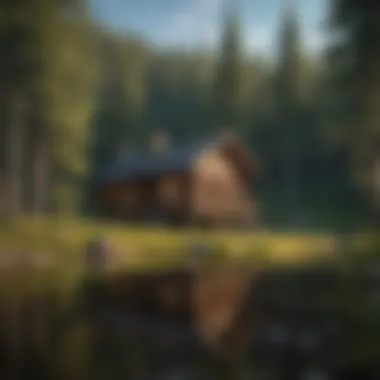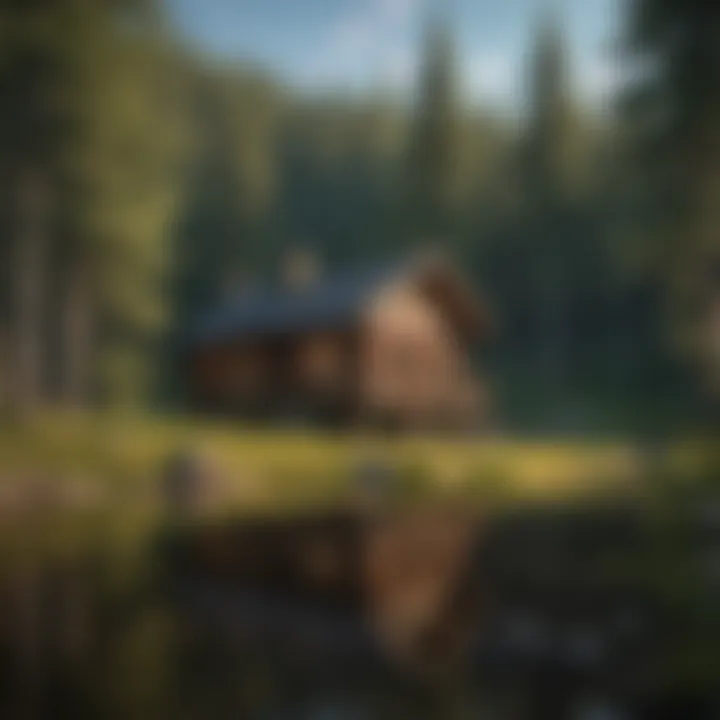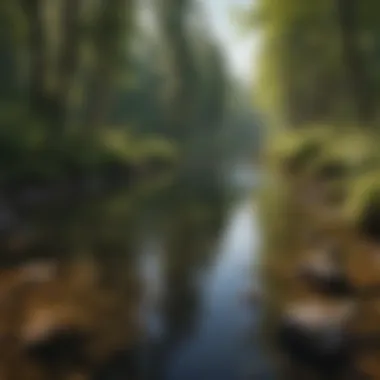Explore Polebridge: Lodging Guide for Nature Lovers


Intro
Polebridge, Montana, serves as a small but significant bridge between the wilderness and the comfort of human habitation. Located near the stunning Glacier National Park, this area attracts those with a deep appreciation for nature. This guide is designed to provide insights for nature enthusiasts looking to explore lodging options in Polebridge. From understanding local ecosystems to recognizing the importance of sustainable practices, each aspect will enhance your experience in this serene landscape.
Visitors often overlook the intricate balance of biodiversity found in the forests surrounding Polebridge. This region holds a rich tapestry of life, and the importance of maintaining it cannot be understated. Exploring the lodging options will reveal that many local establishments prioritize environmental stewardship, making it easier for visitors to connect with nature.
Understanding Woodland Ecosystems
Woodland ecosystems are vital to the health of our planet. They provide numerous benefits, from supporting biodiversity to regulating the climate. Understanding these elements is crucial for any nature enthusiast.
Importance of Biodiversity in Forests
Biodiversity in forests ensures that various species can thrive. This biodiversity supports ecosystem functions, such as pollination, pest control, and nutrient cycling. The forests around Polebridge feature a range of species, both flora and fauna. Protecting these organisms is essential, as their interactions contribute to the overall health of the environment.
Role of Forests in Climate Regulation
Forests significantly influence climate regulation. They act as carbon sinks, absorbing carbon dioxide from the atmosphere. Through photosynthesis, trees store carbon, thus helping to mitigate climate change. The forests near Polebridge play a crucial role in maintaining regional climate stability, offering a cooler environment that benefits both local wildlife and human visitors.
Sustainable Forestry Practices
Sustainable forestry practices emphasize the need to manage forest resources responsibly. As nature enthusiasts plan their trip to Polebridge, understanding these practices can enhance their appreciation of the landscape.
Principles of Sustainable Forestry
Sustainable forestry revolves around several key principles:
- Environmental Integrity: Maintaining ecological systems and processes.
- Social Responsibility: Ensuring that local communities receive benefits from forest resources.
- Economic Viability: Supporting local economies through responsible forest management.
These principles guide how local businesses operate in Polebridge, ensuring that tourism does not come at the cost of forest health.
Case Studies of Successful Implementations
Many organizations implement sustainable forestry practices across Montana. For example, the Montana Department of Natural Resources and Conservation works to balance sustainable logging with habitat protection. By studying these implementations, visitors can learn about effective strategies that protect and enhance the beauty of the wilderness.
Woodland Stewardship Techniques
Effective woodland stewardship is essential for preserving the beauty and integrity of Polebridge's natural environment. Understanding various stewardship techniques can inform visitors about their role in conservation efforts.
Forest Management Plans
Forest management plans are essential documents that outline how forests will be managed over time. These plans typically include:
- Assessment of forest health
- Recommendations for species diversification
- Strategies for pest control
Individuals, businesses, and even local governments are involved in creating and implementing these plans.
Conservation Strategies
Conservation strategies focus on preserving the ecological integrity of forests. This can include:
- Protection of endangered species habitats
- Controlled burns to manage flora and fauna
- Restoration of native plant species
Such strategies ensure that forests can continue to thrive. For visitors to Polebridge, supporting businesses that embrace these conservation measures helps promote responsible tourism.
"Visiting protected regions like Polebridge not only gifts us with unparalleled beauty but also provides an opportunity to participate in forest stewardship."
In summary, appreciating the lodging options in Polebridge is more than just finding a place to sleep. It’s also about understanding the natural systems at play, the importance of sustainable practices, and recognizing the vital role that each visitor can play in promoting woodland stewardship.
Prologue to Polebridge
Understanding Polebridge is essential for anyone looking to immerse themselves in the beauty of Montana's wilderness. This area, relatively remote, offers unique lodging options suited for nature lovers seeking both adventure and tranquility. By exploring the geographical attributes and historical context of Polebridge, visitors can appreciate the environment before they ever set foot on it.
Moreover, knowledge of this backdrop enriches the overall experience, helping travelers connect not just with nature, but also with the cultural stories embedded in the land.
Geographic Overview
Polebridge sits at the northern edge of Glacier National Park, a place where the rugged Rocky Mountains meet lush forests and expansive meadows. It straddles the boundary between the chaotic beauty of mountain landscapes and the calmness of the surrounding natural environment.


The region is characterized by its varied topography. One can find dense coniferous forests, sweeping vistas, and crystal-clear rivers, all converging to create an idyllic natural playground. Access to Polebridge typically involves a drive along unpaved backroads, which adds another layer of adventure.
Visitors can enjoy activities that include hiking, kayaking, and wildlife observation. There are also seasonal highlights, such as wildflower blooms in the spring and vibrant foliage in the autumn.
Historical Background
Polebridge has a rich history that is woven into the fabric of its community and the land itself. Initially, the area was inhabited by Indigenous peoples who thrived on its natural resources. They utilized the land's bounty for sustenance and crafted tools and art reflecting their connection to the environment.
In the late 19th century, settlers discovered the region primarily for agriculture and logging. They established a tight-knit community relying on the surrounding resources. Some remnants of this history are visible in the architecture and local customs that persist today.
As awareness of natural preservation grew in the 20th century, the focus of the community shifted towards conservation efforts. Polebridge has since become known for its commitment to preserving its breathtaking landscape, resulting in a harmonious blend of heritage and ecology.
The essence of Polebridge lies in its melding of nature and history, providing a space for reflection and deeper connection with the environment.
The geographical and historical identifiers serve as a roadmap not just to its past, but as a guiding force for sustainable practices embraced by its residents. For nature enthusiasts, knowing the roots and land form can greatly enhance their visit.
Lodging Options in Polebridge
The choice of lodging can significantly enhance the experience of any visit to Polebridge, Montana. Understanding the different lodging options available allows travelers to select accommodations that align with their preferences and needs, making their time in this idyllic location memorable. This section discusses various options including cabins, camping sites, and local inns. Each type of lodging offers unique benefits while also accommodating diverse preferences for comfort, immersion in nature, and overall experience.
Cabins and Cottages
Cabins and cottages in Polebridge provide an opportunity to immerse in the beauty of nature while still enjoying many home comforts. They are typically nestled in the woods or along the banks of rivers, giving guests direct access to the surrounding landscape. Staying in a cabin or cottage often offers more space than traditional hotel rooms, making them suitable for families or groups traveling together. These accommodations frequently boast amenities like kitchens, which allow for self-sufficient meal preparation, enhancing the overall experience in a remote location.
Moreover, many cabins are designed to blend seamlessly with their natural surroundings. They often feature large windows that offer panoramic views of the landscape, allowing guests to appreciate the beauty of Polebridge from the comfort of their lodgings. For those who appreciate the rustic charm, these options strike a balance between comfort and adventure.
Camping and RV Parks
Camping remains an adventurous way to experience the natural environment Polebridge has to offer. The region is home to several camping grounds and RV parks that cater to various levels of camping experience. For the more adventurous traveler, tent camping can provide an authentic experience surrounded by nature. Many camping spots are positioned close to trails, rivers, and wildlife, allowing for easy exploration right from the campsite.
For individuals or families traveling in RVs, multiple RV parks offer necessary facilities, including water, electricity, and waste disposal services. These parks enable guests to experience camping with the comforts of home while still being surrounded by the wild beauty of Montana. Camping can additionally encourage socializing with other travelers, creating a sense of community among nature enthusiasts.
Local Inns and Lodges
Local inns and lodges in Polebridge present another appealing lodging option, particularly for those seeking a more traditional hospitality experience. These establishments often reflect the character and culture of the region, adding depth to a visitor's experience. Staying at a local inn or lodge provides access to knowledgeable staff who can recommend nearby attractions, activities, and local dining options.
Many of these lodgings take pride in their personalized service, creating welcoming atmospheres that encourage guests to relax. In some cases, meals are provided, incorporating local ingredients which highlight the culinary traditions of the area. This not only adds convenience for visitors but also supports local farmers and businesses. Choosing a local inn or lodge enhances the connection to the community and helps promote sustainable tourism practices.
In summary, the lodging options in Polebridge cater to a spectrum of preferences and ensure every nature enthusiast finds their ideal home base from which to explore the region.
Each option offers distinct advantages, and carefully considering the choices will lead to a more enriching and enjoyable experience in this remarkable part of Montana.
Sustainable Lodging Practices
Sustainable lodging practices are crucial in maintaining the ecological integrity of regions like Polebridge. As more people seek to immerse themselves in nature, the demand for accommodations that minimize environmental footprints has risen. This section highlights the significance of sustainable practices in lodging, detailing the various elements that contribute to achieving this goal.
The benefits of adopting sustainable lodging practices are manifold. Firstly, they help to conserve natural resources, such as water and energy. These accommodations often implement energy-efficient systems, including solar panels or energy-efficient appliances, which reduce overall electricity consumption. Moreover, by emphasizing water conservation measures, such as low-flow showerheads and landscaping that requires less irrigation, they contribute positively to the local ecosystem.
Increased awareness of environmental issues has also led travelers to prefer accommodations that align with their values. By booking stays in places that practice sustainability, visitors not only enjoy a more responsible travel experience but also support local economies that prioritize ecological stewardship.
A well-informed traveler can evaluate the sustainability of their lodging choices, focusing on certifications or practices that demonstrate commitment to the environment. This ensures that their stay aligns with the principles of conservation and community support.
Eco-Friendly Accommodations
In Polebridge, many accommodations honor eco-friendly principles. These include lodges and cabins that utilize sustainable building materials, promote energy conservation, and integrate naturally into the surrounding environment. The architecture typically focuses on minimal disturbance to the landscape and local wildlife, enhancing the guest experience while respecting nature.
Visitors often notice features such as:
- Natural Insulation: Many establishments use materials like straw bales or reclaimed wood, which provide effective insulation without synthetic resources.
- Composting Toilets: Some cabins include composting toilets, a sustainable solution that reduces water usage and provides natural fertilizers for local plants.
- Solar Power: Eco-friendly lodgings frequently harness solar energy for heating water or powering appliances, showcasing a strong commitment to renewable energy practices.
This attention to eco-friendliness serves both the environment and the guests who seek a more immersive experience with nature.
Local Sourcing and Materials
Using locally sourced materials is a hallmark of sustainable lodging in Polebridge. Accommodations that prioritize local procurement demonstrate a dedication to minimizing transportation emissions and supporting the regional economy. This approach also ensures that materials are suitable for the local climate, enhancing durability and reducing the need for frequent repairs.
When accommodations utilize local craftsmanship, they can often offer unique and authentic experiences that reflect the area's culture and heritage. Examples include:
- Furniture and Decor: Items crafted by local artisans using indigenous materials not only provide aesthetic pleasure but also tell the story of Polebridge’s artistic traditions.
- Food and Beverage Options: Many establishments incorporate local produce and goods into their dining options, promoting a farm-to-table ethos that supports local agriculture while offering guests fresh and seasonal choices.
- Sustainably Harvested Wood: Logging practices in the area that focus on sustainability help ensure that the natural beauty of the region remains intact, with accommodations built from responsibly sourced timber.


Overall, the commitment to local sourcing enriches the guest experience while fostering community ties. Through these sustainable practices, Polebridge continues to lead by example, showcasing how traveler choices can positively impact both nature and local culture.
Amenities and Services
Understanding the importance of amenities and services in Polebridge is essential for travelers looking to maximize their experience in this natural haven. Such features contribute significantly to the overall enjoyment and comfort of a stay. They can enhance convenience and provide opportunities for relaxation after a day spent exploring the surrounding wilderness.
From cozy dining spots to recreational options, the availability and quality of amenities can shape a visitor's experience in numerous ways. As guests immerse themselves in nature, these services help to bridge the gap between outdoor adventure and necessary comforts, ensuring a fulfilling exploration.
Dining Options
In Polebridge, dining options reflect the local culture and heritage. Many establishments offer farm-to-table experiences, utilizing fresh local ingredients to produce wholesome meals. The Polebridge Mercantile, for example, serves delicious baked goods and sandwiches that provide a quick refuel for adventurers before hitting the trails.
Dining choices range from casual to more sit-down experiences. Visitors can also find small cafes that serve locally brewed coffee, making it easy to start the day refreshed. Notably, many dining spots are designed to provide a relaxing atmosphere, often with views of nature. That makes each meal an opportunity to take in the surroundings.
- Popular dishes often feature local game meats, such as elk or bison.
- Seasonal menus align with available ingredients, giving guests a taste of the region.
- It's advisable to check operating hours, as some places may be seasonal or have limited schedules.
Recreational Activities
Recreational activities available in Polebridge are abundant, catering to all interests and skill levels. Given the area's natural beauty, outdoor enthusiasts will find numerous opportunities for exploration. Popular activities include:
- Hiking: Many trails vary in difficulty and length, allowing for both short day hikes and longer excursions. Popular trails lead into nearby Glacier National Park, offering stunning views and diverse terrain.
- Kayaking and Canoeing: For those seeking water adventures, local rivers and lakes provide options for paddling. Wildlife sighting is often rewarding during these activities.
- Wildlife Tours: Guided tours are available for those wanting to learn about local fauna while minimizing ecological impact. Professional guides often share insights about conservation efforts in the region.
The presence of these recreational services enriches the visit, enabling guests to engage deeply with nature while ensuring safety and enjoyment. Additionally, the options to rent equipment or join guided tours lessen the burden of planning and allow for spontaneity in adventure planning.
Activities for Nature Enthusiasts
Engaging with the natural environment is a fundamental aspect of visiting Polebridge, Montana. The region is rich in rugged beauty and diverse ecosystems. Nature enthusiasts are often drawn here not only for relaxation but for a deeper connection with the land. In this section, we will explore various activities that allow visitors to immerse themselves in the natural world. Hiking, wildlife observation, and photography are key elements of the Polebridge experience. Each offers unique benefits and considerations that can enhance a trip.
Hiking and Exploration
Hiking in Polebridge is both a recreational opportunity and an invitation to explore pristine landscapes. The local trails vary in difficulty, catering to different skill levels. Popular routes include areas within Glacier National Park, where hikers can enjoy breathtaking views and rich biodiversity.
- Physical Benefits: Hiking promotes physical health and wellness. The activity encourages cardiovascular fitness and builds strength.
- Mental Health: Connecting with nature can alleviate stress. Many find solace in the calmness of surrounding woods.
While hiking, always plan routes carefully. Weather conditions may change rapidly in mountainous areas. Carrying sufficient water and appropriate gear is essential for safety.
Wildlife Observation
Polebridge's surroundings are home to various species of wildlife. From majestic elk to elusive bears, opportunities for observation abound. Wildlife watching educates visitors and fosters appreciation for biodiversity.
- Best Practices: Observers should maintain a respectful distance. Use binoculars or cameras with good zoom capabilities to avoid disturbing the animals.
- Ethical Considerations: Understanding animal behavior is crucial. It is important to avoid feeding wild animals, as dependency on humans can be detrimental.
Joining guided tours may offer insight into local fauna, enhancing the overall experience. Local guides often share knowledge about the region’s ecological balance and conservation efforts.
Photography Opportunities
For those passionate about photography, Polebridge provides a wealth of stunning landscapes. The interplay of light, the vast expanses, and the detailed textures of flora and fauna create an ideal setting for capturing memorable images.
- Golden Hours: Early mornings and late afternoons are typically the best times for photographing landscapes. The soft light highlights details and casts beautiful shadows.
- Techniques: Experimenting with different angles and settings can lead to impressive results. Consider close-ups of plants or panoramas of mountain vistas.
There are also organized photography workshops available for those wanting to refine their skills. Collaborating with experienced photographers can provide valuable techniques and artistic perspectives.
Conclusion: Activities in Polebridge present more than just leisure; they allow for personal growth and enlightening connections with nature. Engaging in hiking, wildlife observation, and photography fosters a greater understanding of the area’s ecological significance. Every approach in nature is an opportunity for reflection and respect for the environment.
Exploring these activities will not only enrich your stay but also encourage a deeper commitment to environmental stewardship.
Local Culture and Community
Understanding the local culture and community in Polebridge is crucial for anyone looking to immerse themselves in the true essence of this picturesque area. The community here is deeply connected to its natural surroundings, reflecting a way of life that is both traditional and sustainable. Engaging with local culture enriches the travel experience, offering insights into the history, craftsmanship, and values that define Polebridge.
Art and Craftsmanship
Polebridge boasts a vibrant art scene, where local artisans express their connection to nature through various mediums. The craftsmanship in this region is not just about aesthetics; it often tells stories of the land, wildlife, and the people who inhabit it. Many artists draw inspiration from the landscape, creating pieces that resonate with both visitors and locals.
Visitors can find handmade goods at local galleries and shops. From pottery to woodworking, art reflects the spirit of the area. These items often serve as reminders of the natural beauty found here. Supporting local artists helps sustain the economy and fosters a sense of community pride.
Community Events


Community events in Polebridge are essential to fostering connections among locals and visitors. These events range from seasonal fairs to art shows and outdoor festivals. They provide opportunities for networking and cultural exchange, inviting people to experience local traditions firsthand.
These gatherings often feature:
- Live Music: Showcase of local talent.
- Food Stalls: Offering regional flavors and homemade delicacies.
- Workshops: Where visitors can learn skills like pottery or trapping.
Participating in community events allows visitors to interact with residents, creating a shared experience that enriches their understanding of the area. These interactions can lead to lasting memories and an appreciation for the cultural fabric of Polebridge. The sense of unity that events foster is a testament to the resilience and spirit of this unique community.
Engaging with local craftsmanship and community events enhances the travel experience, offering deeper insights into the social and cultural dynamics of Polebridge.
By understanding and appreciating the local culture, visitors to Polebridge can forge connections that go beyond mere tourism, fostering a more impactful and memorable experience.
Environmental Considerations
Understanding the environmental impact of our choices is essential when visiting Polebridge, Montana. The region boasts a rich natural landscape, cherished by locals and visitors alike. As nature enthusiasts seek lodging, they must consider the effects of their stay on the environment. This section will explore conservation efforts and the implications for local wildlife.
Conservation Efforts
In Polebridge, conservation is not just a buzzword. It is a guiding principle for hospitality providers and visitors. Many local lodges and cabins embed eco-friendly practices within their operations. These include minimizing waste, promoting recycling programs, and utilizing renewable energy sources.
Several organizations are dedicated to preserving the ecosystem of the area. For instance, the Glacier National Park Conservancy plays a vital role in maintaining trails and protecting wildlife habitats. By participating in conservation initiatives, lodging establishments can create a sustainable tourism model that benefits both the nature enthusiasts and the environment.
Visitors can support these efforts by choosing accommodations that align with these values. Stay at eco-lodges that emphasize sustainability, or participate in local volunteer projects that help to restore trails and habitats. Engaging with the community and its conservation goals enriches the travel experience.
Consistent actions towards healing our environment yield significant improvements over time. Every small effort counts.
Impact on Local Wildlife
Polebridge is home to a diverse array of wildlife, including bears, elk, and numerous bird species. Understanding how human activity influences these populations is crucial. Lodging choices can either contribute to conservation efforts or negatively impact habitats.
When choosing accommodations, consider those that focus on wildlife education. Establishments like Polebridge Mercantile often provide insight into local fauna, helping guests understand their surroundings better. Using proper waste management practices also helps reduce human-wildlife conflicts. For example, food waste should never be left out, as it can attract animals into urban areas where they may be at risk.
Moreover, responsible recreation is vital. Encouraging visitors to stay on marked trails prevents the destruction of delicate ecosystems. In addition, promoting the importance of observing wildlife from a distance ensures safety for both the animals and the spectators.
Planning Your Trip
Planning your trip to Polebridge is crucial for fully enjoying what this remote Montana location has to offer. Preparing well can enhance the experience, ensuring you make the most of your stay. Many aspects play a role in how you can best enjoy your time in Polebridge, from understanding seasonal changes to the logistical considerations of travel.
The beauty of Polebridge lies in its natural landscapes; therefore, knowing the best times to visit can greatly impact your experience. Moreover, understanding how to reach Polebridge is key, considering its position outside of major urban areas. Having a plan reduces uncertainty and makes the journey more enjoyable.
Best Times to Visit
The best times to visit Polebridge largely depend on your interests. Spring and summer offer milder weather, making them ideal for hiking and outdoor activities. The months of June through September see the highest tourist activity, which means that accommodations might be in high demand.
In contrast, fall can be magical with vibrant foliage and fewer visitors, offering a peaceful retreat. Winter conditions can be harsher; however, winter sports enthusiasts may find enjoyment in the snow-covered landscapes. It’s essential to check seasonal weather patterns before making plans, as fluctuations can significantly affect accessibility.
When planning your trip, consider the activities you wish to engage in, as they often dictate the choice of season.
Traveling to Polebridge
Traveling to Polebridge requires careful consideration. The nearest significant city is Kalispell, located approximately 65 miles away. From here, visitors typically rent a car or use personal vehicles. The drive itself can be scenic, but it is vital to remain cautious.
Ensure your vehicle is equipped for mountain driving, especially during winter months. For public transport, options are limited but available, such as catching a bus to Kalispell and arranging for local transport thereafter.
Other key travel tips include:
- Fueling Up: Gas stations are few; ensure you refill in Kalispell.
- Supplies: Bring along necessary food and supplies, especially if you plan for remote activities.
- Maps and GPS: While mobile signals can be weak, having physical maps can be very helpful.
Overall, a well-structured plan for traveling to Polebridge not only saves time but also leads to a more fulfilling adventure in this beautiful region.
Epilogue
The conclusion of this article holds significant weight as it encapsulates the journey that readers have taken through Polebridge's unique lodging landscape. By summarizing the key points discussed, it not only reinforces the valuable information presented but also serves as a final call to action for potential visitors. The importance of this section lies in weaving together the diverse elements that make Polebridge appealing to nature enthusiasts. Here, the intersection of sustainable practices, local culture, and rich opportunities for outdoor adventure converge, showing how these components harmoniously contribute to an unforgettable experience.
Summary of Key Points
In revisiting the highlights, we consider three major aspects:
- Diverse Lodging Options: From rustic cabins and homely cottages to designated camping grounds, Polebridge provides a plethora of lodging choices catering to various preferences. Each option allows for different levels of interaction with nature, ensuring that guests can find a comfortable and suitable stay.
- Emphasis on Sustainability: The focus on eco-friendly accommodations reflects the community’s commitment to protecting the surrounding environment. By being mindful of our impact, travelers can enjoy their adventures while also contributing to the conservation of this beautiful region.
- Engagement with Local Culture: The cultural fabric of Polebridge is woven through its art, craftsmanship, and community events. Engaging with locals fosters a deeper connection to the area and promotes a sense of belonging for visitors.
Encouragement for Exploration
Polebridge is not merely a destination; it is a chance for holistic engagement with nature and community. Embracing the wilderness here invites you to reconnect with the environment and discover the sensitivities of its ecosystems.
As you plan your visit, think beyond conventional tourism. Seek out local artisans, participate in festivals, or hike the lesser-known trails. This area offers layers of experience that go much deeper than a surface-level adventure.







